Like two thirds of adults, I wear glasses. For us petites, especially those of us with small or narrow faces, finding a pair of eyeglass frames to fit can be a big challenge. Most of the world’s glasses are made for people with average-sized faces.
But glasses are part of us; the first thing most people see. They might be the most important piece of clothing most of us buy. Which means that every time I need new frames, I have an immense shopping challenge ahead.
If you have a small face and struggle to find glasses to fit, read on.
Do you have a petite face?
What size eyeglass frames do you need? It’s about more than just the width of the frame.
Most glasses have measurements with 3 components to them. For instance, this pair measures 55-15-140, which refers to an eye width of 55mm per frame, a bridge width (the nose piece joining each eye) of 15mm, and a temple length of 140mm.

Many glasses also include a measurement called “B”, which is the vertical height of the frame. So in total, there are four relevant measurements: Eye, Bridge, Temple, and Height.
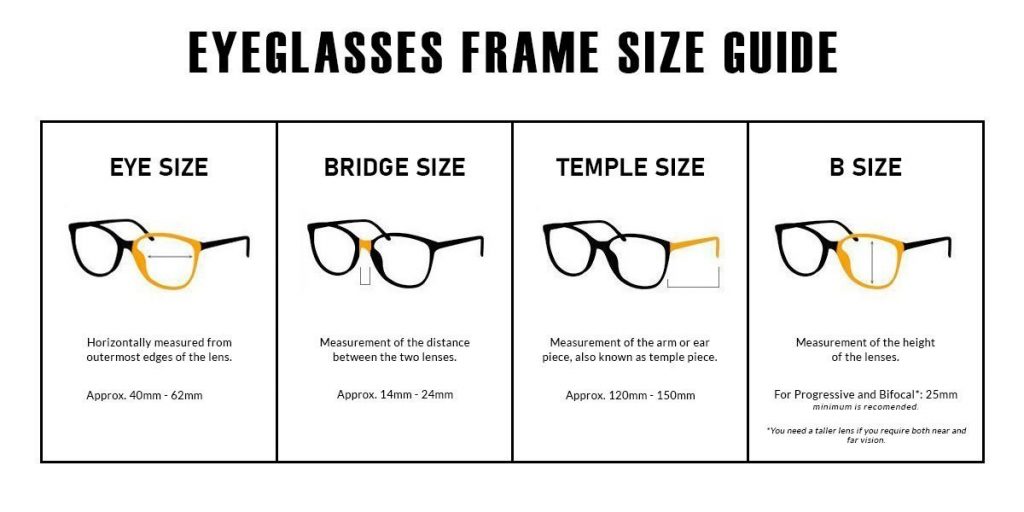 Frames with a lens width or eye size of under about 49mm are considered to be “small” or “narrow”, while 49-54mm are usually “medium” and are the most commonly found eye size. 55mm and above are generally “large” widths and are more commonly found in men’s eyeglasses. Eye sizes under 46mm are generally kids’ or junior sizes.
Frames with a lens width or eye size of under about 49mm are considered to be “small” or “narrow”, while 49-54mm are usually “medium” and are the most commonly found eye size. 55mm and above are generally “large” widths and are more commonly found in men’s eyeglasses. Eye sizes under 46mm are generally kids’ or junior sizes.
However, since different shapes of lenses will have different ratios, just knowing your lens width isn’t enough. Round frames may have a narrower eye size, but a wider bridge to compensate. Rectangular or cat-eye frames could be the opposite, with wider eye size.

What you really need to know is the total width of your face that you need, from temple to temple, represented by the number 1 on the diagram below:

You can easily calculate that for your favourite pair of frames by doubling the eye size and adding the bridge width. For instance, my current glasses have an eye size of 48mm each, and a bridge width of 15mm, which adds up to 111mm.

If your total horizontal measurement (2x eye size + bridge) totals less than 115mm, your face is considered “petite” or “extra narrow”, and shopping for glasses can be a real challenge. Typically, this translates into a lens size of 45-49mm, depending on the shape of the frame.
Why are petite frames so hard to find?
You’ve heard this theme before on my blog, and it’s the same story here: It’s a numbers game.
An estimated ten percent of women need petite or extra-narrow glasses. An even smaller or negligible proportion of men do, too. That means that the demand for petite frames makes up less than 5% of the eyewear industry’s total sales.
Most retailers operate on volume and can only afford to carry so much inventory. They’ll tend to focus on the most popular sizes, which fit the widest range of faces. That means you’ll see a ton of 52mm frames (the most popular women’s size), but almost nothing in a 47 or 48 (my size).
What about that B number?
The “B” measurement, or lens height, is often not given on the inside of the frame, so it might be a bit tricky to find. But it can be critical in terms of getting the right fit, especially for petites. Lenses that are the right width, but too tall in vertical, will sit uncomfortably on your cheekbones and will look awkward on your face.
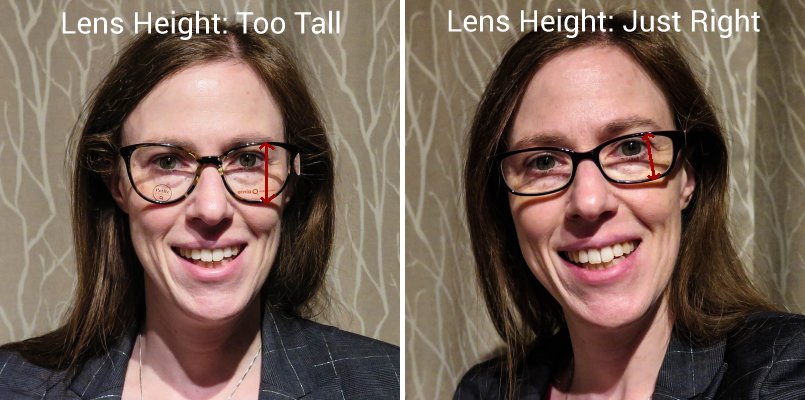
Conversely, lenses that are too narrow might restrict vision. This is especially important for those of us over 40 who need progressive lenses. Typically, the minimum frame height for progressive lenses is 28mm. My current frames are 30mm tall, which makes them pretty close to the smallest possible size for my progressive lenses, and has led me to need to invest in more expensive premium lenses to compensate for the smaller size. Just another way we petites end up paying more for everything. But anyway.
Choosing the right frame shape
There’s a lot of guidance out there on how to determine your face shape and, therefore, your theoretical ideal eyeglass frame shape. Basically, there are four main frame shapes: Rectangular, oval, round, or cat-eye. And within this, an endless list of options.

There are so many different supposedly-scientific ways of finding your face shape by using measurements, sketches, or other methods. I personally vouch for the trial-and-error method: In other words, try on a bunch of frames, see which ones look good and which ones don’t, and chalk up the ill-advised purchases to error.
Personally, I’ve learned through lots of trial and error that I’m best suited with frames that are wider than they are tall (more rectangular shape), that have a cat-eye or ascending feature at the temple, and that aren’t too round.

Eyeglass fashion trends are cyclical too, just like all other trends. Right now, for instance, oversized round frames are in, and petite or rectangular frames are out. That makes it even harder on those of us with petite or small faces, or who don’t do well with rounder shapes, to find glasses. The choices can be really limited in some years, and seemingly abundant in others.
This year in particular was tough for shopping, and I found myself purchasing a pair of discontinued frames from two years ago because nothing in most lines’ current stock worked for me. The frustration is real.
 My current frames, by Modo, are a discontinued style from 2019
My current frames, by Modo, are a discontinued style from 2019
Where to shop for petite glasses
So where do you even start with shopping for petite frames? Despite the wide range of options online from sites like Zenni, Warby Parker, or FramesDirect, I always recommend trying frames on in person. Even frames listed online as “petite” or “narrow” may not be small enough or the right shape for your face. Not to mention the endless variation in colours, styles, materials (metal, plastic, acetate), and the small nuances of fit. It’s always better to try, try, try.
There’s another consideration for us petites when shopping for glasses: Pupillary distance, usually measured as PD. This is the distance between the pupils, or centres of your eyes. Most of the time, your prescription from your eye doctor will not include the PD measurement, as it is typically measured when you buy your frames and lenses.
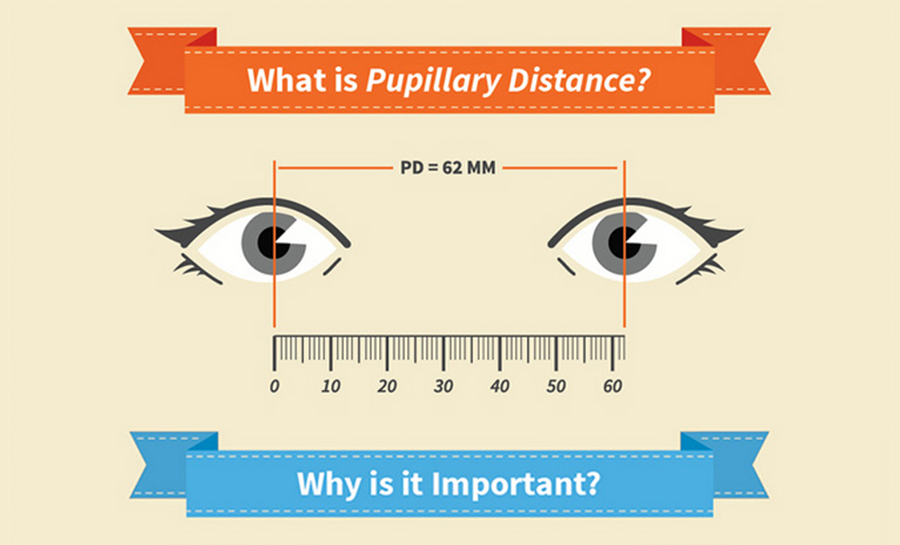
For petites, especially those of us with small faces and closer-set eyes, our PD distance might be significantly smaller than average. If ordering your glasses online, some sites have virtual measuring guides, or tell you to measure yourself using a webcam or selfie, but these methods can be very inexact. For best results, it’s useful to get professionally measured when you buy your glasses offline, and to deal with an optician that will make adjustments if something is not quite right.
If you have any kind of complexity to your prescription, I find it’s worthwhile to deal with a reputable optician in your area. It can be tempting to shop online to save money, but I’ve found you really do get what you pay for in terms of personalized service when you shop locally.
Here, I’ll give a shout-out to my optician, Doyle in St-Henri, where I’ve been getting my eye exams and buying glasses for years. They’re known for carrying a good selection of frames for smaller faces. While not the cheapest out there, they really go above and beyond in terms of service, even going so far as to custom-order a range of frames in petite sizes direct from the supplier for me to try on in store. Definitely recommended!
Some brands that make petite-friendly frames
The dirty little secret about eyeglass frames is that they’re almost all made by the same company. Regardless of the brand name on the label, they’re probably made and sold under license by Essilor/Luxottica, an Italian company that controls a whopping 80% of the brands in the world’s eyeglasses market. Yes, really.
Not only does this near-monopoly result in ripoff-level high prices for the consumer, but it also means there’s a lack of choice on the market. Mass production favours the middle of the bell curve; those of us who need sizes on either end of it get left out in the cold. Petite frames are hard to find, and you may find yourself paying more than you want just to get a good fit.
Here are a few brands that I’ve found are more likely than others to have petite-friendly frames:
- JF Rey is a French brand that has a Petite line that sells fun and stylish frames for narrow faces.
- Modo is the brand of my current pair of frames. I like how lightweight their super-thin acetate frames are, and many are available in smaller eye sizes including 48 widths.
- Atelier 78 is the in-house brand by Doyle, my local optician. They’re designed here in Quebec, where, for some unknown reason that I’m sure comes down to history or genetics or whatever, there tends to be more demand than usual for frames to fit small faces. This year’s collection has a lot of round shapes, but it varies.
- Etnia Barcelona is an independent eyewear brand that sells bold, stylish, and original frames in a range of designs, including some that are petite-friendly.
- Liz Claiborne has frames that are affordable in narrow fits. Their styles are more classic than contemporary, but I’ve found options here before that fit small faces well.
- Kate Spade is another clothing brand that licenses its name to a collection of eyeglass frames that have decent options for petite faces.
- Bonhomme à Lunettes: If you’re on a restricted budget in Montreal, or simply don’t feel like feeding the Luxottica monopoly machine, check out Bonhomme à Lunettes, which offers eye exams and inexpensive frames, and operates on a pay-what-you-can sliding scale. Frame options in petite or narrow sizes are super limited, though.
For my American readers: I’ve heard of major US retailers, as well as specialty brands like PetiteGlasses.com, that stock a range of options for small or narrow faces. However, as a Canadian, I haven’t had the opportunity to try any of them, so I can’t really comment from personal experience. Feel free to check them out and report back on your experience in the comments.
What about kids’ frames?
If you struggle to find frames that fit your small face, you might be wondering, why not just buy kids’ frames? After all, they’re smaller, they’re cheaper, and they can be just as stylish. Win-win, right?
Well, not exactly.
The thing is, for most adults, petite frames can be too small. The eyes will be set too close together, the nose bridge might be too narrow, and the temple length (the part that goes behind your ears) can be too short.
Frames too small for your face can dig in, be uncomfortable, and look off. Also, if you have a progressive lens, too small frames can make it challenging to see at certain parts of the lens.
Check out what I mean to see the subtle difference:
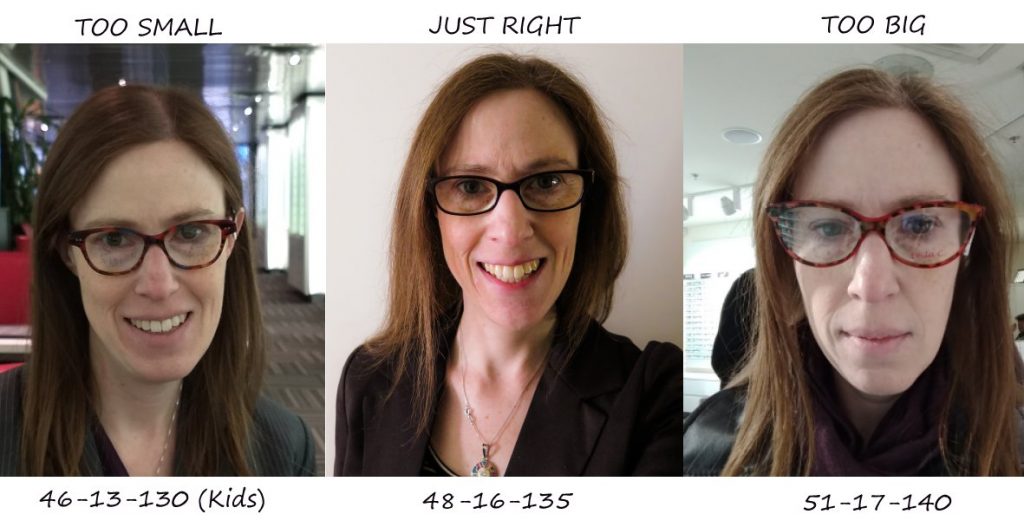
Furthermore, while neutral kids glasses do exist, a lot of them come in loud colours with cartoon logos and designs that are, well, childish. Not exactly ideal if you’re a grown woman. And since kids are so prone to breaking their glasses, a lot of their frames come in thicker plastic that is resistant to breakage, but somewhat less than elegant.
I’m in that in-between spot where kids’ frames are too small on me, and most adult frames are too large. Only once did I give into frustration and buy a pair of child frames. They were uncomfortable and ill-fitting, and I definitely won’t make that mistake twice.
Additional shopping tips
- Metal versus plastic can be a matter of personal preference. Metal is lighter, thinner, more minimalistic in look, and less prone to breakage, but the nosepieces can dig in uncomfortably, and they can irritate anyone with a metal allergy. Plastic frames have gotten thinner and lighter with technology improvements, and are available in a wider range of colours and styles. Personally I’ve owned both and I find I prefer plastic frames.
- Check with your optician on whether the frames you try are appropriate for your prescription. Rimless or semi-rimless glasses may not work as well for stronger prescriptions, or may require you to invest in a high-index lens. As mentioned above, if you wear progressive glasses, you’ll need to make sure the lens is tall enough to accommodate them.
- Colour choice can be limited for us petites; when we finally find the perfect pair of frames, they may only be available in a couple of colour choices. I could write a whole post on how to choose the right frame colour to suit your skin tone, eye colour, and overall palette, but that’s a subject for another day.
- One more piece of advice during COVID times: Try on frames without a mask! Ideally, don’t remove your mask in the store; it’s too risky. But see if your optician will allow you to leave a deposit and take frames home to try on safely. You may notice that frames that seemed okay actually come too far down on your face or end up being too big.
 All these frames appeared to fit decently with a mask on, but all but the top left pair
All these frames appeared to fit decently with a mask on, but all but the top left pair
were too big once I got them home and tried them without a mask.
Hopefully this post has inspired you to find the perfect fitting pair of glasses to bring out your unique petite awesomeness. Happy shopping!

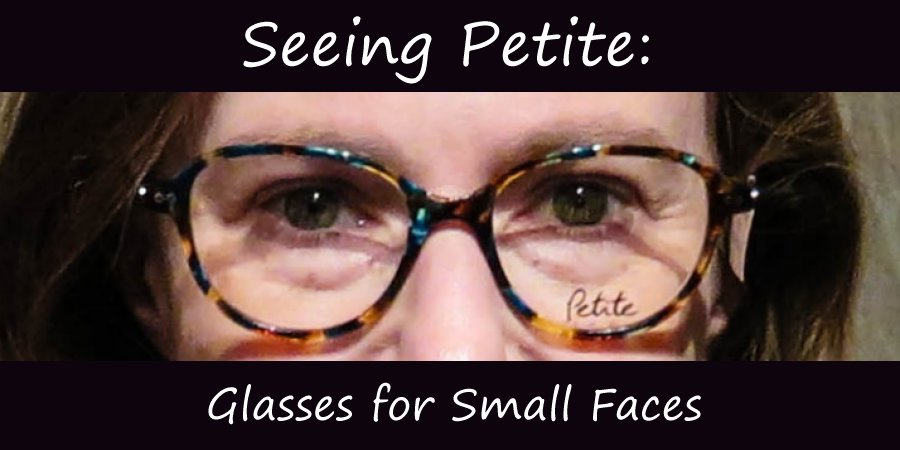



I work in the field and I’ll add a couple other brands of frames to check out that cater to petite –
Kliik, nearly all their frames range from 47-50 eye size and are very petite-friendly.
Ann Taylor Petite, also a great line.
Nifties – even has some extra petite like 45-46 eye size.
All three are definitely worth checking out. They aren’t Luxottica brands so you can often find them in your local optical stores that are not part of the big chains.
Thank you, that’s so helpful!
Very helpful! Thanks. I’ve also found the brands Fysh, and KLiiK to have petite sizes.
Thank you so much for posting this! It works out that we share the same face shape, glasses shape preference and sizing, so I really get the struggle! I agree fully to just try before you buy- I also require progressive lenses with a higher prescription and need all the added coatings and indexing which makes glasses quite an investment each purchase. It’s best to get the advice and sizing done in person.
Thank you so much for doing the leg work! I have not been satisfied lately with the fit of my glasses – this definitely helps!
Brilliant find! Thanks for writing this information for others to find, so useful ;0)
I actually think the round frames look great on you, even the ones that you say are too high. When I google “stylish frames” most of the pictures are of women wearing glasses that are quite large with respect to their vertical height. It’s frustrating to me when I go to optical ships and they keep trying to fit me with frames that are really small in that dimension because I have a small face. Maybe they fit me better, but I just don’t think it looks stylish!